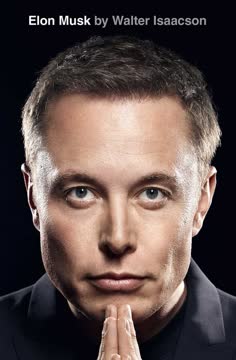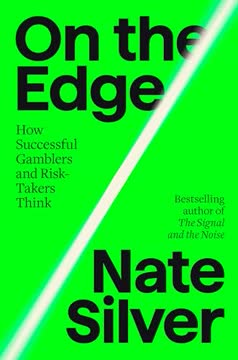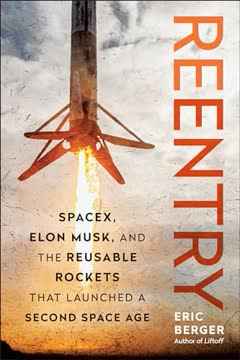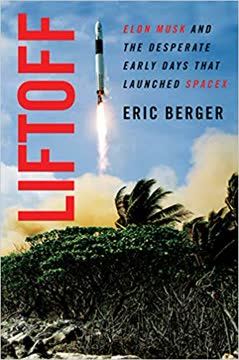Key Takeaways
1. Musk's Vision: Reusability as the Key to Space Settlement
Musk’s genius is that he not only saw this future but believed in it enough to keep pushing, to keep fighting, and to will it into existence.
The reusability imperative. From the outset, Elon Musk recognized that the high cost of space travel was the primary barrier to humanity becoming a multiplanetary species. His solution was to develop fully reusable rockets, capable of launching, landing, and rapidly reflying, drastically reducing the cost per launch. This vision drove SpaceX's engineering decisions and shaped its long-term goals.
Aviation analogy. Musk often used the analogy of commercial airliners to illustrate the importance of reusability. He argued that if airplanes were discarded after each flight, air travel would be prohibitively expensive and inaccessible. Similarly, reusable rockets would make space travel more affordable and sustainable.
Starship as the ultimate goal. While the Falcon 9 was a significant step toward reusability, Musk envisioned Starship as the ultimate solution. This fully reusable rocket system, designed to transport humans and cargo to Mars and beyond, represents the culmination of his vision for a future where space travel is commonplace.
2. Scrappiness and Innovation: The SpaceX Way
“Scrappy was a big word,” Mosdell said. “Back then you had to be scrappy. So when you laid out your plans they had to be scrappy. If everyone in the approval cycle felt they were scrappy enough, you could go for it. If not, they threw you out of the room.”
Resourcefulness under pressure. SpaceX's early years were characterized by limited resources and ambitious goals. This forced the company to be incredibly resourceful, finding innovative solutions to complex engineering problems with minimal funding. This "scrappy" approach became a defining characteristic of the SpaceX culture.
Examples of scrappiness:
- Salvaging materials from abandoned launch sites
- Building a launch pad for a fraction of the cost of traditional contractors
- Improvising solutions to unexpected problems, such as the "Capricorn One" incident
Challenging the status quo. SpaceX's scrappiness extended beyond its engineering practices. The company also challenged the established norms of the aerospace industry, questioning regulations and pushing for more efficient and cost-effective approaches to spaceflight. This disruptive mindset allowed SpaceX to achieve breakthroughs that traditional aerospace companies had long deemed impossible.
3. The Human Cost: Sacrifices and Trade-offs at SpaceX
“We were out there beating history, but Elon was still pissed at us,” Mueller said. “Like everything else we’ve ever done, it was way slower than Elon wanted, and way faster than anyone had ever done it before. It was pretty much the story of our lives.”
Relentless demands. Musk's relentless pursuit of ambitious goals often came at a cost to his employees. Long hours, intense pressure, and a constant sense of urgency were hallmarks of the SpaceX work environment. This demanding culture, while driving innovation, also led to burnout and personal sacrifices for many employees.
Examples of sacrifices:
- Engineers working seven days a week for months on end
- Employees sleeping at the factory to meet deadlines
- Strained relationships and personal lives due to work demands
A Faustian bargain. Working at SpaceX offered the opportunity to be part of something extraordinary, to push the boundaries of human achievement. However, this opportunity came with a price: a willingness to sacrifice personal time, well-being, and sometimes even ethical considerations in pursuit of Musk's vision.
4. The Importance of Key Relationships: NASA, the Air Force, and SpaceX
“I told him that as far as the Wing was concerned, this was for the good of the Wing, and the good of the country,” Helms said. “And General Chilton also believed that SpaceX was going to shake up the industry in a way that the government would find advantageous. He agreed to back me up.”
Navigating bureaucracy. SpaceX's success depended not only on its engineering prowess but also on its ability to navigate the complex world of government contracts and regulations. Building strong relationships with key figures at NASA and the Air Force was crucial for securing funding, obtaining launch licenses, and overcoming bureaucratic hurdles.
Key relationships:
- Susan Helms: The Air Force commander who approved SpaceX's lease of SLC-40
- Bill Gerstenmaier: The NASA official who championed commercial spaceflight
- Kathy Lueders: The NASA manager who balanced safety with innovation
A delicate balance. SpaceX's relationships with government agencies were often fraught with tension. The company had to balance its entrepreneurial spirit with the need to comply with regulations and maintain the trust of its government partners. This required a delicate dance of pushing boundaries while respecting established protocols.
5. Failure as a Stepping Stone: Learning from Explosions and Setbacks
“The Merlin rocket engine is a violent beast,” Tom Mueller said.
Embracing risk. SpaceX's willingness to embrace failure as a learning opportunity was a key factor in its success. The company viewed explosions and setbacks not as defeats but as valuable data points that informed future designs and improved reliability. This iterative approach, while unconventional in the aerospace industry, allowed SpaceX to rapidly innovate and overcome technical challenges.
Examples of learning from failure:
- The Falcon 1's multiple launch failures leading to the successful fourth flight
- The CRS-7 explosion leading to improvements in the Falcon 9's design
- The drone ship landing attempts leading to the development of precise landing techniques
Turning setbacks into strengths. SpaceX's ability to learn from its mistakes and adapt its approach was a testament to its engineering talent and its commitment to continuous improvement. This resilience allowed the company to overcome seemingly insurmountable obstacles and ultimately achieve its ambitious goals.
6. The Power of a Compelling Mission: Inspiring Employees and Overcoming Obstacles
“I thought it was the coolest thing ever,” he said.
A shared vision. Elon Musk's vision of settling Mars served as a powerful motivator for SpaceX employees. This grand, audacious goal inspired them to work long hours, overcome technical challenges, and make personal sacrifices in pursuit of a common purpose. The mission provided a sense of meaning and purpose that transcended the daily grind of engineering work.
Examples of mission-driven behavior:
- Employees working through holidays and weekends
- Engineers taking on tasks outside their expertise
- A willingness to endure intense pressure and scrutiny
A culture of belief. The shared belief in Musk's vision created a strong sense of camaraderie and loyalty among SpaceX employees. This culture of belief allowed the company to attract and retain top talent, fostering a collaborative environment where innovation could thrive.
7. Starlink: Funding the Dream of Mars
“We should remind our customers that they’re helping life as we know it become multiplanetary,” Musk said. “You could be giving money to fucking Comcast. Or you could help humanity get beyond Earth. Those are your two options.”
A revenue engine. While Musk's vision for Mars was inspiring, it required a sustainable source of funding. Starlink, SpaceX's satellite internet constellation, emerged as a potential solution. By providing high-speed internet access to underserved areas, Starlink could generate billions of dollars in revenue, which could then be used to finance the development of Starship and the colonization of Mars.
A dual-purpose project. Starlink not only provided a revenue stream but also offered valuable experience in satellite design, manufacturing, and operations. This expertise would be crucial for building a communications network on Mars, enabling future colonists to stay connected with Earth and each other.
A high-stakes gamble. The Starlink project represented a significant financial risk for SpaceX. Developing and launching thousands of satellites required a massive upfront investment, with no guarantee of success. However, Musk believed that the potential rewards were worth the risk, as Starlink could unlock the financial resources needed to make his Mars vision a reality.
8. The Inevitable Clash: Musk's Vision vs. Traditional Space
“It was intense,” Richeson said. “It was the most sincere I had ever seen the man. That was the first time I understood this dude was not kidding around, that this was literally the entire mission for the company.”
Challenging the old guard. SpaceX's disruptive approach to spaceflight often clashed with the established norms of the aerospace industry. Traditional contractors, accustomed to cost-plus contracts and lengthy development cycles, viewed SpaceX as a threat to their dominance. This clash of cultures led to political battles, regulatory hurdles, and skepticism from some corners of the space community.
Examples of clashes:
- Opposition from Lockheed Martin to SpaceX's lease of SLC-40
- Skepticism from NASA officials about SpaceX's safety protocols
- Resistance to SpaceX's innovative engineering solutions
A new space age. Despite the opposition, SpaceX's success has ushered in a new era of space exploration. By lowering launch costs, fostering innovation, and inspiring a new generation of engineers, SpaceX has transformed the space industry and paved the way for a future where space travel is more accessible and sustainable.
Last updated:
FAQ
1. What is Reentry: SpaceX, Elon Musk, and the Reusable Rockets that Launched a Second Space Age by Eric Berger about?
- Comprehensive SpaceX history: The book chronicles SpaceX’s journey from its early struggles with Falcon 1 to the revolutionary development of reusable rockets like Falcon 9 and Falcon Heavy.
- Focus on innovation and leadership: It explores Elon Musk’s vision, leadership style, and the company culture that enabled SpaceX to disrupt the aerospace industry.
- Industry context: Berger situates SpaceX’s achievements within the broader space industry, highlighting competition with legacy players and the shift from government to private enterprise in spaceflight.
2. Why should I read Reentry by Eric Berger?
- Insider perspective: The book offers a rare, detailed look inside SpaceX’s operations, based on interviews with employees and firsthand accounts of technical and organizational challenges.
- Understanding Musk’s leadership: Readers gain a nuanced view of Elon Musk’s ambitions, management style, and the impact of his vision on SpaceX’s trajectory.
- Lessons on innovation: Berger’s narrative provides valuable insights into risk-taking, rapid iteration, and perseverance in a high-stakes industry.
3. What are the key takeaways from Reentry by Eric Berger?
- SpaceX’s transformative impact: The company revolutionized spaceflight with reusable rockets, lowering costs and commercializing human spaceflight.
- Leadership and culture: Elon Musk’s relentless drive and the company’s scrappy, risk-tolerant culture were central to its success, but also brought challenges like burnout and turnover.
- Future uncertainties: Berger highlights concerns about Musk’s distractions, the need for strong successors, and the ongoing challenge of maintaining innovation and momentum.
4. How does Eric Berger describe Elon Musk’s leadership style in Reentry?
- Relentless and demanding: Musk sets aggressive goals and expects employees to work at an intense pace, often under high stress and tight deadlines.
- Visionary but polarizing: His ambition to make humanity multiplanetary drives SpaceX’s mission, but his controversial decisions and public persona sometimes create internal and external friction.
- Hands-on involvement: Musk is deeply involved in technical decisions and crisis management, personally intervening in key moments to push for rapid innovation.
5. How does Reentry by Eric Berger explain SpaceX’s work culture and its effects?
- Intense and mission-driven: Employees often work 80-100 hour weeks, motivated by belief in SpaceX’s mission to revolutionize spaceflight and settle Mars.
- High turnover and burnout: The demanding environment leads to significant burnout, especially among managers, though it also attracts passionate “true believers.”
- Leadership stability: Figures like Gwynne Shotwell provide essential stability and balance to Musk’s high-pressure leadership style.
6. What were the major technical challenges SpaceX faced in developing reusable rockets, according to Reentry?
- Engine ignition and clustering: Lighting nine Merlin engines simultaneously on Falcon 9 was a major hurdle, with early reliability issues and complex engineering problems.
- Landing and reentry technology: Developing controlled descent methods, such as grid fins and propulsive landings, required extensive testing and innovation.
- Quality control and failures: Incidents like the CRS-7 and AMOS-6 failures exposed weaknesses in supplier management and quality assurance, prompting improvements.
7. How did SpaceX achieve rocket reusability, and why is it significant according to Reentry?
- Drone ship and land landings: SpaceX pioneered techniques to land Falcon 9’s first stage on autonomous drone ships and on land, overcoming numerous failures through iterative engineering.
- Economic breakthrough: Reusing rockets drastically reduced launch costs, making space more accessible and enabling higher launch frequency.
- Historic achievement: The first successful Falcon 9 landing in December 2015 marked a turning point in spaceflight, validating years of effort and changing industry expectations.
8. How did NASA and government contracts influence SpaceX’s development, as described in Reentry?
- Critical early funding: NASA’s contracts for ISS cargo delivery provided essential financial support and validation, helping SpaceX survive early setbacks.
- Regulatory challenges: SpaceX had to navigate strict safety and regulatory requirements, often clashing with traditional aerospace culture.
- Partnership evolution: Over time, NASA developed a collaborative relationship with SpaceX, balancing oversight with flexibility and enabling historic milestones like the first Dragon berthing.
9. What were the key moments and challenges in the development and operation of the Dragon spacecraft in Reentry?
- Early design and funding: NASA contracts in 2006 and 2008 enabled SpaceX to develop Dragon for ISS cargo missions, focusing on cost-effective and simple design choices.
- Demonstration and recovery: Dragon’s first flight in 2010 successfully orbited Earth and was recovered from the Pacific, proving the viability of commercial cargo delivery.
- Operational hurdles: SpaceX had to meet NASA’s rigorous certification standards with limited resources, innovating with cost-saving measures and extensive software testing.
10. How did SpaceX’s relationship with NASA evolve through the Commercial Crew program, according to Reentry?
- Initial skepticism: NASA was initially doubtful of private companies’ ability to safely fly astronauts, favoring established contractors like Boeing.
- Crew Dragon innovations: SpaceX introduced new features like touchscreen controls and propulsive landing concepts, facing technical and regulatory resistance.
- Historic success: The successful Demo-2 mission in 2020 ended U.S. reliance on Russian Soyuz spacecraft and marked a new era in commercial human spaceflight.
11. How did SpaceX’s competitors respond to its rise, as detailed in Reentry by Eric Berger?
- ULA’s decline: United Launch Alliance lost market share to SpaceX due to slower innovation and higher costs, with its Atlas V and Delta IV rockets becoming less competitive.
- Boeing’s Starliner struggles: Boeing faced delays and technical failures with its Starliner spacecraft, contrasting with SpaceX’s rapid progress and risk-taking culture.
- Blue Origin’s lag: Jeff Bezos’s Blue Origin fell behind, with no orbital launches by 2023 and internal culture issues slowing its progress compared to SpaceX.
12. What is the significance of Starship in Reentry and how does it relate to Elon Musk’s Mars vision?
- Starship as a game-changer: Starship is designed as a fully reusable, super heavy-lift rocket capable of carrying large crews and cargo to Mars and beyond.
- Enabling Mars settlement: Musk’s vision is for Starship to make a self-sustaining city on Mars possible, relying on in-situ resource utilization for propellant.
- Technical and financial hurdles: Building Starship at scale is unprecedented and costly, with Musk planning to fund it through ventures like Starlink and emphasizing the need for rapid, affordable reusability.
Review Summary
Reentry by Eric Berger chronicles SpaceX's journey from 2008 to 2023, detailing the company's innovations, challenges, and dominance in the space industry. Readers praise Berger's balanced reporting, insider access, and engaging storytelling. The book highlights SpaceX's relentless work culture, technological breakthroughs, and Elon Musk's pivotal role. While some criticize the non-linear narrative, most appreciate the behind-the-scenes insights into SpaceX's achievements. Reviewers note the book's relevance to understanding modern space exploration and Musk's impact on the industry.
SpaceX Series Series
Similar Books










Download PDF
Download EPUB
.epub digital book format is ideal for reading ebooks on phones, tablets, and e-readers.





